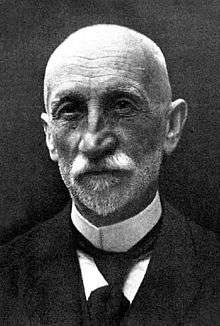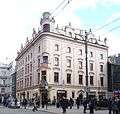Władysław Ekielski
Władysław Ekielski (17 February 1855 – 23 June 1927) was a Polish architect active in Kraków, known for his work in the eclectic and modern style.
Władysław Ekielski | |
|---|---|
 | |
| Born | February 17, 1855 |
| Died | June 23, 1927 (aged 72) Kraków |
| Citizenship | Polish |
| Occupation | architect |
Biography
Ekielski was born and raised in Kraków. He came from a bourgeois family. His father Eustachy Ekielski was a notary, and his mother was Elżbieta née Sieradzka.[1]
He attended the St Ann's Gymnasium. Between 1872–1876 he studied at the Institute of Technology in Kraków, and between 1876–1880 at the Construction Department of Vienna Polytechnic. After the graduation, he worked in the studio of Heinrich von Ferstel in Vienna.
In 1882 he came back to Kraków and began work with Tadeusz Stryjeński, initially as an employee, later as his partner. Together, they performed a number of competition projects in Kraków, some of which has been implemented, including the Wołodkowicze Palace in the 1880s, the Pusłowscy Palace in 1886 and the Aleksander Lubomirski Foundation Hospice (currently the main building of the Kraków University of Economics) in 1893.[1][2]
In 1886, Ekielski obtained building license and started teaching as a lecturer at the Kraków Municipal School of Applied Arts (Miejska Szkoła Przemysłu Artystycznego). He was also a teacher of drawing at the k.k. College of Industry in Kraków (Wyższa Szkoła Przemysłowa).[1]
He made projects of tenement houses at Karmelicka Street 42, Studencka Street 14, Szpitalna Street 4, Grodzka Street 26 and Piłsudskiego Street 14. At Piłsudskiego Street 40, he designed his own house called A House With Two Fronts. He also authored Willa Julia in Podgórze in 1903, and Suski House at Grodzka Street 24–26 in 1906–1909.
He carried out architectural work on the construction of the Adam Mickiewicz Monument at the Kraków Main Square, and completed the construction of the New Synagogue in Tarnów.
In the course of renovations carried out since 1895 at the presbytery and the nave of the Franciscan Church in Kraków, he made a discovery of the original plan of the building.[1] Later, he offered Stanisław Wyspiański to execute the polychromy of the interior of the Church.[3]
In 1900, he co-created and became the editor-in-chief of the monthly magazine The Architect (Architekt).[1] In the years 1904–1906, together with Wyspiański, he developed a design for the reconstruction of the Wawel Hill, known as Akropolis.[4] This project has never been implemented. In 1902, together with Antoni Tuch, he set up a stained-glass plant, which in time was transformed into the Kraków Stained-Glass Plant S. G. Żeleński (Krakowski Zakład Witrażów S. G. Żeleński).[5]
Since 1918, Ekielski was a professor at the Jan Matejko Academy of Fine Arts.
On May 2, 1922, he was awarded the Officer's Cross of the Order of Polonia Restituta.[6].
In 1896 he married Zofia Stiasny. They had three sons and two daughters.[1]
He died in 1927, and was buried at the Rakowicki Cemetery.[7]
Projects (selection)
 Wołodkowicze Palace in Kraków (1880s)
Wołodkowicze Palace in Kraków (1880s)- Pusłowscy Palace in Kraków (1886)
- The Aleksander Lubomirski Foundation Hospice (currently the main building of Kraków University of Economics) (1893)
.jpg) The House With Two Fronts, the own house of Władysław Ekielski at Piłsudskiego Street 40 (1898)
The House With Two Fronts, the own house of Władysław Ekielski at Piłsudskiego Street 40 (1898) Willa Julia at Lasoty Square 2 in Kraków (1903)
Willa Julia at Lasoty Square 2 in Kraków (1903)- City hall in Skawina (1904)
 Powiat office in Bochnia (1893–1907)
Powiat office in Bochnia (1893–1907) New Synagogue in Tarnów (completion of the construction; opened in 1908, destroyed by the Nazis in 1939)
New Synagogue in Tarnów (completion of the construction; opened in 1908, destroyed by the Nazis in 1939) Suski House at Grodzka Street 24–26 in Kraków (1906–1909)
Suski House at Grodzka Street 24–26 in Kraków (1906–1909)
Written works
- Zadania i stanowisko urzędu budownictwa miejskiego w Krakowie (in Polish). Kraków: Published by the author. 1895.
- Akropolis: pomysł zabudowania Wawelu obmyśleli Stanisław Wyspiański i Władysław Ekielski w latach 1904-1906 (in Polish). Kraków: Drukarnia Uniwersytetu Jagiellońskiego. 1908.
- Odbudowa polskiej wsi: odczyt wygłoszony na kursach ekonomiczno-społecznych Instytutu Ekonomicznego N.K.N. (in Polish). Kraków: Nakładem Centralnego Biura Wydawnictw N. K. N. 1916.
- "Wspomnienie o Wyspiańskim: z teki pośmiertnej arch. W. Ekielskiego". Rzeczy Piękne (in Polish). 1–12: 3–11. 1932.
| Wikimedia Commons has media related to Władysław Ekielski. |
References
- Świszczowski, Stefan. "Ekielski Władysław (1855 – 1927)". Polski Słownik Biograficzny. VI. pp. 221–223.
- "Władysław Ekielski" (in Polish). dziejekrakowa.pl. Archived from the original on 11 September 2014. Retrieved 20 June 2019.
- Krasnowolski, Bogusław (2007). "Stanisław Wyspiański a zabytki Krakowa" (PDF). Alma Mater (in Polish). 97: 26–28.
- Ekielski, Władysław; Wyspiański, Stanisław (1908). "Akropolis. Pomysł zabudowania Wawelu". Architekt (in Polish). 9 (5–6): 49–57.
- Karolczak, Kazimierz (1987). Właściciele domów w Krakowie na przełomie XIX i XX wieku. Z badań nad dziejami Krakowa. Wydawnictwo Naukowe WSP. p. 160.
- Order Odrodzenia Polski. Trzechlecie pierwszej kapituły 1921–1924. Warszawa: Prezydium Rady Ministrów. 1926. p. 23.
- Grodziska, Karolina (2003). Zaduszne ścieżki – przewodnik po Cmentarzu Rakowickim. Kraków. p. 133.